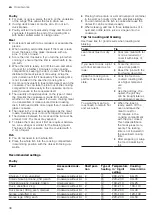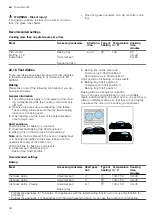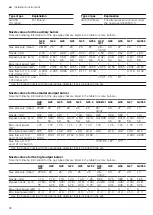
How it works
en
43
22.15 Proving dough
You can prove yeast dough more quickly in your appli-
ance than at room temperature.
Proving dough
Always allow yeast dough to prove in two steps: Once
in its entirety (dough fermentation) and a second time
in the baking tin (final fermentation).
1.
Place the dough into a heat-resistant bowl.
2.
Place the bowl on the wire rack.
3.
Use the recommended settings when configuring
the appliance settings.
Only start operation when the cooking compartment
has fully cooled down.
4.
Do not open the appliance door while the dough is
proving, otherwise moisture will escape.
5.
Continue processing the dough and mould it into
the final shape for baking.
6.
Place the dough into the cooking compartment at
the specified shelf position.
Tip:
If you want to preheat the oven, do not carry out
the final proving stage in the appliance.
Recommended settings
Proving dough
The temperature and time are dependent on the type and quantity of the ingredients. The values in the table are
therefore guide values only.
Meal
Accessory/cookware Shelf posi-
tion
Type of
heating
Temperature
in °C
Cooking time,
minutes
Yeast dough, light
1.
Bowl
2.
Universal pan
1.
2
2.
2
1.
2.
1.
50
1
2.
50
1
1.
25–30
2.
10–20
Yeast dough, heavy and rich
1.
Bowl
2.
Universal pan
1.
2
2.
2
1.
2.
1.
50
1
2.
50
1
1.
60–75
2.
45–60
1
Preheat the appliance for 5 minutes.
22.16 Defrosting
For defrosting frozen fruit, vegetables and baked items.
Poultry, meat and fish should ideally be defrosted in
the refrigerator. Not suitable for cream cakes or cream
gateaux.
When defrosting food, use the following shelf positions:
¡
1 wire rack: Shelf position 2
¡
2 wire racks: Shelf positions 3+1
Note:
Food that is frozen in thin layers or small portions
defrosts more quickly than food frozen in larger blocks.
¡
Take the food out of its packaging and place in a
suitable dish on the wire rack.
¡
Redistribute the food or turn it once or twice as it
defrosts. Turn large pieces of food several times. As
the food defrosts, break up any clumps and remove
items that have already defrosted from the appli-
ance.
¡
To allow the temperature to equalise, leave the de-
frosted food to rest for another 10 to 30 minutes in
the appliance after switching it off.
Recommended settings
Defrosting
Meal
Accessory/cookware
Shelf position
Type of
heating
Temperature
in °C
Cooking
time,
minutes
Baked items, cake and
bread, fruit, veget-
ables, meat products
Wire rack
2
3+1
-
-
22.17 Cooking more than one dish/course at
a time
You can cook more than one dish at a time in your ap-
pliance. This way, the appliance is able to use less en-
ergy and you are able to use the cooking positions effi-
ciently.
Note:
The cooking result depends on the quantity of
food and the size of the ovenware.
For pasta bakes, use wide, shallow cookware.
If you want to follow one of your own recipes, use the
settings listed in the table for similar food as reference.
Observe the following explanations.
¡
To cook the food, place it into the appliance at
levels 1, 3 and 5.
¡
Place the cookware on the wire rack at the specified
level.
¡
Once the time specified in the table has elapsed, re-
move the accessory containing the food from the
oven.














































